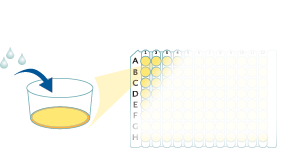Mouse Oncostatin M (OSM) Quantikine ELISA Kit Summary
Product Summary
Recovery
The recovery of mouse OSM spiked to three levels throughout the range of the assay in various matrices was evaluated.
| Sample Type | Average % Recovery | Range % |
|---|---|---|
| Cell Culture Media (n=4) | 97 | 92-103 |
| EDTA Plasma (n=4) | 95 | 92-100 |
| Heparin Plasma (n=4) | 99 | 94-106 |
| Serum (n=4) | 100 | 95-109 |
Linearity
Scientific Data
Product Datasheets
Preparation and Storage
Background: Oncostatin M/OSM
Oncostatin M (OSM) is a cytokine originally isolated from medium conditioned by PMA-treated U-937 human histiocytic leukemia cells based on its ability to inhibit growth of A375 melanoma cells. The human OSM cDNA encodes a 252 amino acid pre-pro-OSM polypeptide with a 25 residue hydrophobic signal peptide and a hydrophilic C-terminal domain that are proteolytically processed to generate the 196 residue mature form of OSM. Although both mature and pro-OSM are equally active in radio-receptor assays, the mature OSM is 5- to 60-fold more active in growth inhibition assays. Thus, proteolytic processing of the pro-OSM peptide may be important in regulating the in vivo activities of OSM. OSM initiates its biological activities by binding to specific cell surface receptors. The gp130, a signal transducing component (beta subunit) of the IL-6, LIF and CNTF receptor complexes, was identified as a low-affinity OSM receptor that does not transduce OSM signals. The low affinity LIF receptor (LIF R, a gp130-related protein) has now been identified to be a component of a high-affinity OSM receptor that will transduce OSM signals. Since OSM is also active on cells that do not express LIF R, a specific OSM receptor that does not involve LIF R must also exist. Besides its growth inhibitory activities on human A375 melanoma and mouse M1 myeloid leukemic cells, as well as on other solid tumor cells, OSM also has growth stimulatory activities on normal fibroblasts, AIDS-Kaposis sarcoma cells, and a human erythroleukemia cell line, TF-1. Other OSM-mediated activities reported to date include: stimulation of plasminogen activator activity in cultured bovine aortic endothelial cells, regulation of IL-6 expression in human endothelial cells, and stimulation of LDL uptake and up-regulation of cell surface LDL receptors in HepG2 cells.
Human Oncostatin M (OSM) signals through two types of human OSM receptor complexes: the type I complex comprising the leukemia inhibitory factor receptor beta (LIF R beta) and gp130 and the type II complex made up of OSM receptor beta (OSM R beta) and gp130. In contrast, mouse OSM signals only through the mouse OSM R beta and gp130 complex. Human and mouse OSM R beta are 55% identical at the amino acid sequence level.
Assay Procedure
Refer to the product- Prepare all reagents, standard dilutions, and samples as directed in the product insert.
- Remove excess microplate strips from the plate frame, return them to the foil pouch containing the desiccant pack, and reseal.
- Add 50 µL of Assay Diluent to each well.
- Add 50 µL of Standard, Control, or sample to each well. Cover with a plate sealer, and incubate at room temperature for 2 hours.
- Aspirate each well and wash, repeating the process 3 times for a total of 4 washes.
- Add 100 µL of Conjugate to each well. Cover with a new plate sealer, and incubate at room temperature for 2 hours.
- Aspirate and wash 4 times.
- Add 100 µL Substrate Solution to each well. Incubate at room temperature for 30 minutes. PROTECT FROM LIGHT.
- Add 100 µL of Stop Solution to each well. Read at 450 nm within 30 minutes. Set wavelength correction to 540 nm or 570 nm.





Citations for Mouse Oncostatin M (OSM) Quantikine ELISA Kit
R&D Systems personnel manually curate a database that contains references using R&D Systems products. The data collected includes not only links to publications in PubMed, but also provides information about sample types, species, and experimental conditions.
2
Citations: Showing 1 - 2
Filter your results:
Filter by:
-
Exercise Suppresses Head and Neck Squamous Cell Carcinoma Growth via Oncostatin M
Authors: Yoshimura, T;Hirano, Y;Hamada, T;Yokoyama, S;Suzuki, H;Takayama, H;Migita, H;Ishida, T;Nakamura, Y;Ohsawa, M;Asakawa, A;Ishihata, K;Tanimoto, A;
Cancers
Species: Mouse
Sample Types: Serum
-
Oncostatin M is a Master Regulator of an Inflammatory Network in Dnmt3a -Mutant Hematopoietic Stem Cells
Authors: Schwartz, LS;Young, KA;Stearns, TM;Boyer, N;Mujica, KD;Trowbridge, JJ;
bioRxiv : the preprint server for biology
Species: Mouse
Sample Types: Bone Marrow Fluid
FAQs
No product specific FAQs exist for this product, however you may
View all ELISA FAQsReviews for Mouse Oncostatin M (OSM) Quantikine ELISA Kit
Average Rating: 5 (Based on 1 Review)
Have you used Mouse Oncostatin M (OSM) Quantikine ELISA Kit?
Submit a review and receive an Amazon gift card.
$25/€18/£15/$25CAN/¥75 Yuan/¥2500 Yen for a review with an image
$10/€7/£6/$10 CAD/¥70 Yuan/¥1110 Yen for a review without an image
Filter by:





